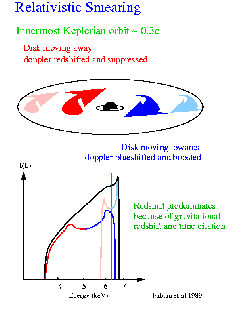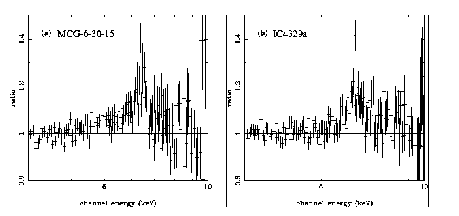
The enourmous luminosity output of Active Galactic Nuclei (AGN) and Quasars arises from the gravitational potential energy released as material falls into a supermassive (107-9 Msun black hole. This produces copious UV and X-ray radiation, so X--ray astrophysics can turn the study of strong gravity into an observational science.
One way to get a diagnostic of the accretion flow very close to the black hole is to look in detail at the X--ray spectrum. A strong iron fluorescence line is excited by X--ray irradiation of the disk, and the combination of Doppler effects from the high orbital velocities and strong gravity in the vicinity of a black hole gives this line a characteristically skewed, broad profile. One of the most exciting astrophysics results of the last few years has been the convincing demonstration that such relativistically smeared lines are indeed seen from a nearby AGN. The most obvious is in MCG-6-30-15 (Tanka et al 1995), where there is a broad, skewed red wing to the line profile, as shown below. This strongly requires that there is illuminated material very close to the last stable orbit around the black hole (3 Schwarzchild radii). However, not all AGN look like this. The second figure shows the rather different line profile from another X--ray bright AGN, IC4329a. The line is broad, but not so dramatically distorted as in MCG-6-30-15. The inner accretion disk either truncates at ~20 Schwartzchild radii, or is not illuminated by the X--ray source, or is so highly ionised that it does not contribute to the line emission (Done, Madejski & Zycki 2000).
